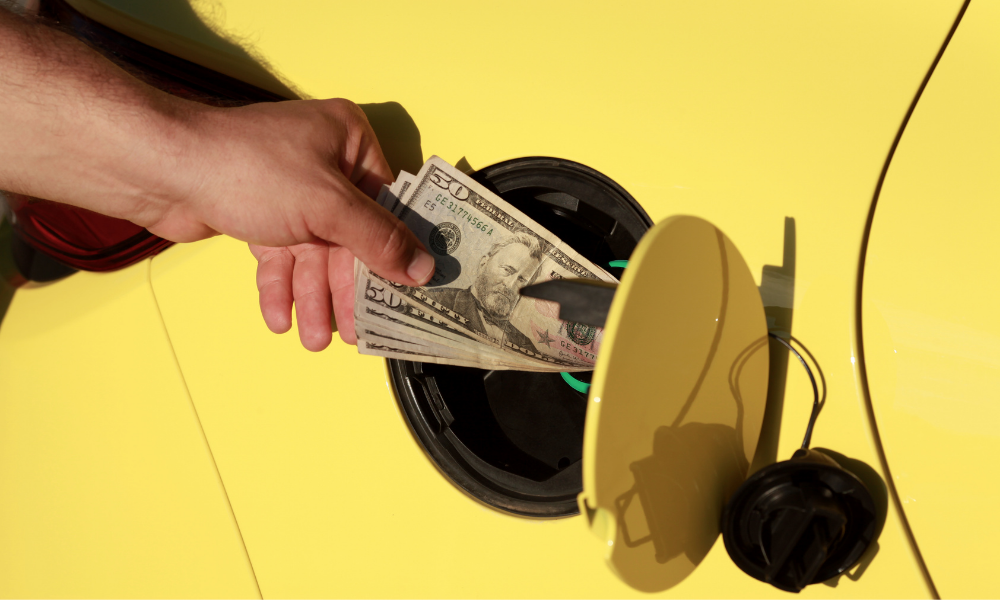
Gas prices continue to rise about 10 cents per gallon a day -- the national average jumped another 9 cents on Saturday, hitting $3.92 per AAA's gas price tracker. That's almost a 10% increase from only a week ago ($3.60) and almost a 50% increase from last year ($2.75).
California made news on Friday as prices pushed past $5 a gallon -- the first time that's happened in any US state ever. The national average price is now only 19 cents below the all-time record of $4.11 in July 2008.
Energy analysts predict $4 a gallon nationwide will be here soon, in big part due to Russia's ongoing invasion of Ukraine.
Here's what you need to know about gas prices, including how high they could go, how the Ukraine crisis and other factors are impacting them, and what the Biden administration can do about it.
Patrick DeHaan, head of petroleum analysis at price tracker GasBuddy, tweeted on Monday that he estimates the national average will hit the $4 a gallon line on March 27. However, at the pace of prices this week, it could happen as early as Sunday, March 6.
Prices on Saturday already average $5.18 a gallon in California and have pushed past the $4 threshold in New York, Connecticut, Illinois, Oregon, Pennsylvania, Arizona, Nevada, Washington, Alaska, and Hawaii.
Gas prices usually hit their peak in spring, DeHaan told ABC 12, as refineries undergo maintenance before the summer driving season.
The cost of gasoline is heavily influenced by the cost of crude oil, which it's refined from. On Friday, the price of Brent crude, the international benchmark, settled at $118.11 a barrel, an increase of nearly 7% from Thursday.
West Texas Intermediate crude, the US standard, rose 7.4% to settle at $115.68 -- the highest since September 2008.
DTN senior market analyst Troy Vincent told CNET that "in a worst-case scenario, with Russian gas and oil fully cut from the global market," crude could go up to $130 a barrel, or even higher.
Brent crude reached an all-time high of $147.50 in July 2008, fueled by a Brazilian oil worker strike and threats to supplies from Nigeria and Iran. At that time, average US gas prices peaked at $4.11 a gallon.
If crude goes that high in 2022, Vincent said, $6.50 or even $7 a gallon wouldn't be out of the realm of possibility.
"At that point, though, it would trigger a global recession," he added. "People would start limiting their activities to the bare essentials."
Russia is one of the world's largest producers of crude and natural gas, providing 10% of the global supply and roughly 40% for the European Union.
While the US is the largest producer of crude oil and natural gas, it's also the largest consumer, producing over 18.6 million barrels a day while using over 20.5 million.
| Revealed In 2022 Best Day Trading Strategies for Beginners |
Last year, the U.S. imported roughly 245 million barrels of crude oil and petroleum from Russia, almost 25% more than in 2020, making it our third largest outside source after Canada and Mexico.
In November alone, about 595,000 barrels per day, or roughly 7%, came from Russia.
While the West has levied major economic sanctions against Russia over its invasion of Ukraine, only Canada has banned crude oil from the former Soviet Union. The US, Europe, and other allies are hesitant to cut off access to a vital resource.
There's not much we can do to change the price of gas, but drivers can cut down on unessential trips and shop around for the best price -- even crossing state lines if it's not inconvenient.
Apps like Gas Guru scan for the best gas prices in your region. Others, like FuelLog, track your car's gas mileage and can help determine if it is getting decent fuel economy.
In addition, many gas station chains have loyalty programs, and credit cards have rewards programs that give cash back for gas purchases.
DTN's Vincent advises against hoarding gas or other extreme measures but encourages budgeting more for gas. High energy prices have been a major contributor to inflation for a while, he said, and won't be going away immediately.
Related Article
14 Business Leaders Share Their Predictions For Consumer Behavior In 2022
NFT Mania Cools Amid Ukraine Crisis As Average Price And Sales Decline From January High
Ukraine Sports Stars Joining Fight Against Russia
"When the cost of crude rises, prices at the pump tend to reflect it very quickly," he said. "But gas prices tend to linger higher longer even when crude falls." Source: MSN